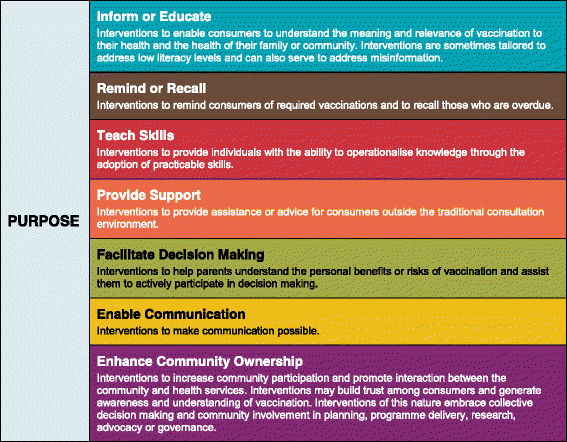The comprehensive 'Communicate to Vaccinate' taxonomy of communication interventions for childhood vaccination in routine and campaign contexts
- PMID: 28486956
- PMCID: PMC5424416
- DOI: 10.1186/s12889-017-4320-x
The comprehensive 'Communicate to Vaccinate' taxonomy of communication interventions for childhood vaccination in routine and campaign contexts
Abstract
Background: Communication can be used to generate demand for vaccination or address vaccine hesitancy, and is crucial to successful childhood vaccination programmes. Research efforts have primarily focused on communication for routine vaccination. However, vaccination campaigns, particularly in low- or middle-income countries (LMICs), also use communication in diverse ways. Without a comprehensive framework integrating communication interventions from routine and campaign contexts, it is not possible to conceptualise the full range of possible vaccination communication interventions. Therefore, vaccine programme managers may be unaware of potential communication options and researchers may not focus on building evidence for interventions used in practice. In this paper, we broaden the scope of our existing taxonomy of communication interventions for routine vaccination to include communication used in campaigns, and integrate these into a comprehensive taxonomy of vaccination communication interventions.
Methods: Building on our taxonomy of communication for routine vaccination, we identified communication interventions used in vaccination campaigns through a targeted literature search; observation of vaccination activities in Cameroon, Mozambique and Nigeria; and stakeholder consultations. We added these interventions to descriptions of routine vaccination communication and categorised the interventions according to their intended purposes, building from an earlier taxonomy of communication related to routine vaccination.
Results: The comprehensive taxonomy groups communication used in campaigns and routine childhood vaccination into seven purpose categories: 'Inform or Educate'; 'Remind or Recall'; 'Enhance Community Ownership'; 'Teach Skills'; 'Provide Support'; 'Facilitate Decision Making' and 'Enable Communication'. Consultations with LMIC stakeholders and experts informed the taxonomy's definitions and structure and established its potential uses.
Conclusions: This taxonomy provides a standardised way to think and speak about vaccination communication. It is categorised by purpose to help conceptualise communication interventions as potential solutions to address needs or problems. It can be utilised by programme planners, implementers, researchers and funders to see the range of communication interventions used in practice, facilitate evidence synthesis and identify evidence gaps.
Keywords: Campaigns; Childhood vaccination; Communication; Immunisation; Interventions; Taxonomy.
Figures
References
-
- European Centre for Disease Prevention and Control. Communication on immunisation – Building trust. Stockholm: ECDC; 2012. http://ecdc.europa.eu/en/publications/Publications/TER-Immunisation-and-.... Accessed 19 July 2016.
-
- Maternal Child Health Integrated Program (MCHIP). Bottlenecks and Breakthroughs: Lessons Learned from New Vaccine Introductions in Low-resource Countries, 2008 to 2013: USAID; 2013. http://www.jsi.com/JSIInternet/Inc/Common/_download_pub.cfm?id=15580&lid=3. Accessed 21 July 2016.
MeSH terms
LinkOut - more resources
Full Text Sources
Other Literature Sources
Medical



